Beautiful hallways: design tips and interesting examples
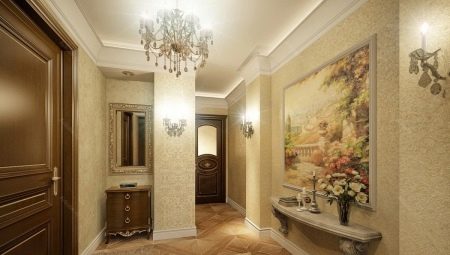
Much has been written about how the entrance hall forms the first impression of a home. Its design speaks of the taste of the owners, so many tend to shock the guests with the design of the hallway. But this is not the main thing in the design of the entrance room. Beauty - yes, but functionality is more important. In this article, you will learn how to combine the two to create a comfortable and inviting hallway.

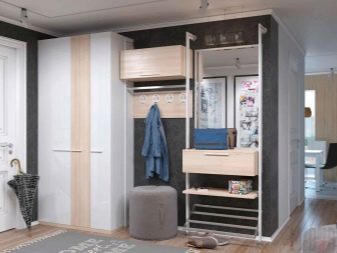

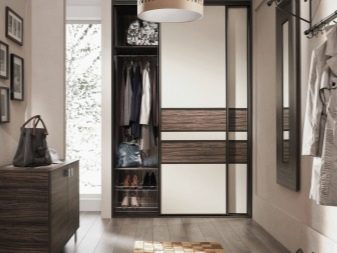
Design features
Professional designers will be able to accurately tell about the design of the hallways and the features of their decoration. But we live in too different conditions, respectively, and the finances that the family is ready to spend on repairs will also be different.



But beautiful is not necessarily expensive. The main thing is to competently use the advice of professionals in order to avoid mistakes in the design of the premises.
- The larger the entrance space, the more the design. The less space, the more you have to think about functionality.

- In a small room, the main thing is not decoration, but furniture... Better to choose built-in wardrobes. Despite the convenience of the wardrobe, it is considered an outdated model. Consider drawers, pivot doors, open shelves.

- The entrance corridor of an ordinary apartment is a place where a large number of personal belongings are accumulated., therefore, pieces of furniture and accessories should be kept to a minimum.
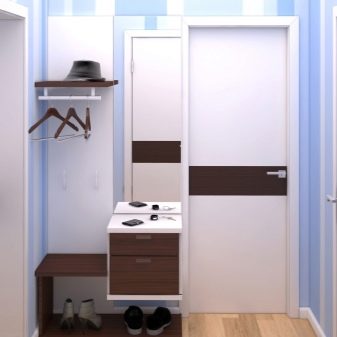

- In a small space, it is much more efficient and safer to use built-in lamps, LED lighting. In large halls, chandeliers, sconces, built-in lighting are appropriate.


- Due to the large number of colorful clothes and shoes, the corridor can be quite colorful. To prevent this from happening, it is recommended to use the minimum number of colors in the design.


In the trends of recent years, black, gray, white, wood color are considered appropriate.
- Whatever area the hallway occupies, it must contain the following items.
- Hanger (open or in a closet).
- Cupboard (wall-mounted or floor-standing) with open shelves or doors. To save space, you should choose wardrobes with mezzanines, which will hide seasonal clothes and shoes.
- Mirror. It is believed that in a room from where people go out into the street, the mirror should be full-length in order to be able to make sure that the appearance is in order. Often cabinet doors are chosen for this. This will save space and visually increase the space.
- Shoe rack, which can also serve as a shelf for keys, gloves and other little things.
- An ottoman, a mini-sofa, an armchair, that is, any place for a seat. This is not a luxury, but a way to protect wallpaper and facades from scuffs. After all, it is uncomfortable to put on shoes while standing, and we instinctively seek support, soiling surfaces. Often a shoe cabinet lid serves as a seat, which saves space.
- Lighting... It may be natural, but more often it is artificial. In a dark corridor, you can hardly manage with one lamp. You will have to use different types of lighting.
- Shoe mat... No matter how sophisticated the entrance room may be, you cannot do without this item. Sterile white hallways with a white glossy floor look strange enough. Indeed, in practice, keeping such beauty in order is problematic.
- Decorative little things - stand for umbrellas, clocks, housekeepers, photographs, paintings - they will be present if there is free space.




Combination of materials, textures and colors
To add aesthetic appeal, it is important to choose the right materials for wall, floor and ceiling decoration, as well as find a balance between the design of these surfaces and the furniture. All materials must meet the following criteria.
- Strength. It is the floor covering of the hallway that experiences the greatest stress, therefore, a high-quality material that is resistant to strong mechanical stress is needed here. The same goes for walls and furniture.
- Moisture resistance. Frequent wet cleaning, wet and dirty shoes should not damage the floor covering. Practical linoleum or tiles are often ahead of laminate or parquet in this indicator.
- Ease of maintenance. Splashes from wet clothes or animal hair, footprints from shoes, street dust should not be conspicuous. This means that the surface should be easy to clean. And the choice of color must match the ability to maintain order. If there is a small child in the house, then caring for a white hallway will be problematic.
- Security. It is not only about the quality of the materials themselves, but also about their combination. Before installing glass doors or shelves, or hanging wall sconces, consider whether there is enough space in the corridor so as not to accidentally break this glass.



But even such restrictions will make it possible to make very beautiful hallways through the use of various textures and colors.
Flooring
All the usual materials are used for the hallway floor. But parquet, artificial and natural stone are less popular due to their impractical maintenance. But ceramic tiles and porcelain stoneware are a common solution to the problem.




A clear plus of such a coating is the variety of shapes and colors of tiles, durability and ease of maintenance.
It is good to lay the carpet where you can pre-clean your shoes (porch, shoe rack in front of the house, rug in front of the door to the apartment). Carpet is not easy to care for, so it is unlikely to be suitable for a large family. But carpet tiles - the modern version of carpet - are a much more practical purchase.

Laminated board firmly won its place in our homes. Low price, color variety, ease of installation are its obvious advantages. But if the installation was carried out by non-specialists, then the laminate can quickly become unusable from high humidity.



Linoleum continues to be popular due to its versatility and availability. Moreover, modern production offers very beautiful options for this coating.

Self-leveling floor - not the cheapest choice, but perhaps the most beautiful. For such a floor, it is enough to add plain furniture and walls, and the hallway will be very beautiful.



"Golden Tile" is a new trend. It is an artificial, very strong and durable material that can imitate other types of finishes.

Walls
In a small hallway, the walls are practically invisible. Therefore, you should not spend a lot of money on finishing them. In large corridors, everything is completely different. The following materials are used for wall decoration.
- Water based or other paint light colors (in a small hallway dark tones are prohibited). The option is only suitable for walls that will not be touched (for a cabinet, for example), since it is problematic to care for them.
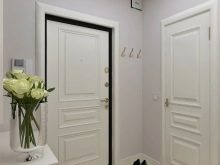


- Decorative plaster in discreet shades. Designers call it the most practical material. She is not afraid of water, easy to clean, shockproof.


- Decorative brick with similar properties. It is worth noting that brick decoration of the entire wall is in fashion, and not individual fragments.




- Wallpapers of various textures and textures, the main thing is without bright large drawings, but rather plain ones. It is worth choosing more durable types: vinyl, liquid, glass wallpaper, cork, bamboo, quartz cloth.
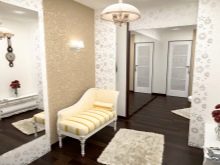
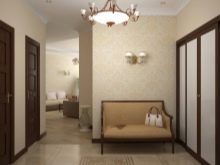

- Plastic panels may seem like an outdated material, but manufacturers offer very interesting options that can adequately decorate your entrance room.

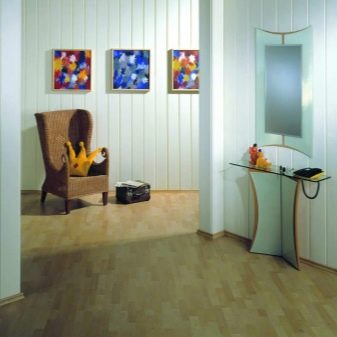
In the large hallway, the situation with the decoration of the walls is different, but here, too, you should not arrange fireworks of colors and materials. Let the walls act as a complement to the surroundings, and not as a "main course."
Ceiling
Usually, the least attention is paid to the ceiling in a small hallway. But it can have a significant impact on the perception of the room. A light ceiling will make the hallway taller, a dark one will reduce the height of the walls. A glossy ceiling will increase the space, a matte ceiling will reduce it.

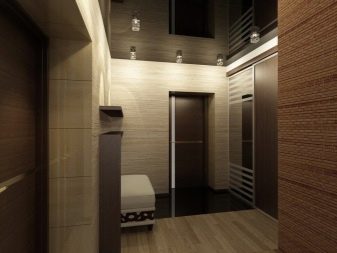


The cheapest way to finish it is painting with different types of paint. The color may not necessarily be white, but it should be several tones lighter than the walls if you want to visually increase the space.

The disadvantage of such a ceiling is the inability to install spotlights.
Stretch ceiling is becoming more and more popular due to its high decorative effect, average price, and quick installation. Glossy stretch ceilings with spotlights can even make the hallway a festive room. But be aware that the time of gloss is a thing of the past.



Suspended structures are the most expensive and labor-intensive. They can be made of plasterboard, PVC panels, wooden battens and other materials. The time of two-level figured ceilings is in the past.


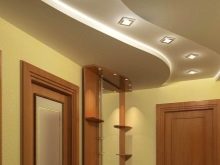
When combining various materials and textures, colors play an important role. Color psychologists recommend a combination of 60/30/10, where 60% is the main color, 30% is the complementary color, and 10% is the accent.
The most common combination of shades brown. This is a calm, non-marking range.
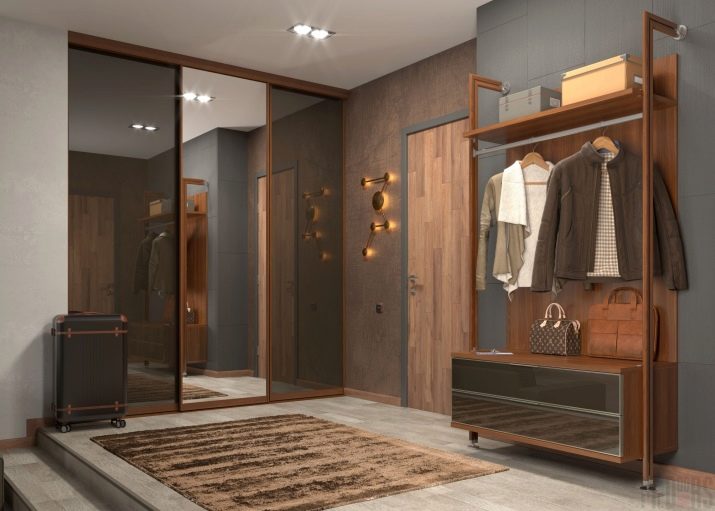
Hallways look very nice in tones of natural wood: bleached oak, beech, walnut, white ash, alder. But professionals do not recommend using the "wood-like" facade, since this technique has already become a stamp in the design.



Shades of gray will be appropriate in combination with any colors.



If you doubt the ability to correctly choose the color scheme, use the color cheat sheet - Itten's circle.
How to arrange furniture correctly?
The arrangement of furniture is directly related to the size of the hallway.A small hallway will be saved by vertical zoning and multifunctional furniture. There should not be a closet at the front door that opens inward, otherwise the door and furniture will interfere with each other. It is better to put here a banquette, a pouf, a bedside table for bags.

The mirror is positioned in such a way that you can see yourself in full growth, but in a safe proximity to the opening doors. Feng Shui experts suggest that the mirror cannot be hung in front of the front door.

A medium-sized hallway will successfully accommodate a corner cabinet. And in the large corridor there is a place for an armchair and a floor lamp.
Lighting and decor as the finishing touch
The lack of natural light in the hallway makes the types of artificial lighting diversify. These can be false windows in the ceiling and on the walls, chandeliers and wall sconces, built-in lamps in ceilings and furniture, spots, LED floor lighting.



It is rarely possible to manage with one type of lighting. Indeed, if you only have a chandelier, your own reflection in the mirror can scare you with the unnatural color. Therefore, often use local luminaires: over the mirror, wardrobe, shoe shelf. And if spotlights often perform a utilitarian function, then wall sconces are also a decorative element that can emphasize the chosen design style.



If the design idea does not allow using several sources, then it makes sense to set spots and direct them to different objects: a wardrobe, a mirror, an entrance door.
Perhaps no professional can do without accessories when decorating a room. But there should not be a lot of decor items in the hallway, and it is desirable that they perform a useful function. For example, the metal frame of the mirror will accentuate the hi-tech style, the striped rug is appropriate for ethnic styles. On open shelves, you can put several bowls in the same style for small items.


The main thing in the design of the hallway is not to overdo it, to find a balance between the implementation of utilitarian functions and the desire to see your hallway stylish.
Interesting examples of the interior of the corridor
Such a false window overlooking the street not only creates a beautiful view, but can also hide the built-in furniture. A clear plus of such a decor will be the lamps built in behind the panels.
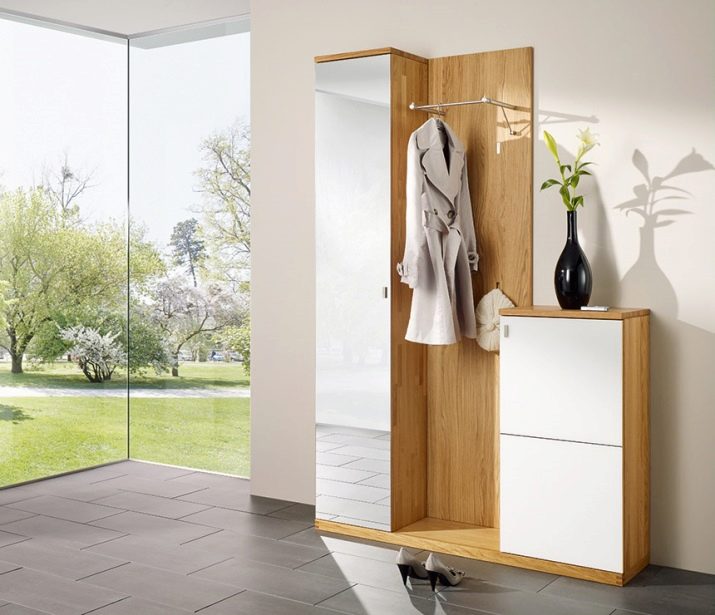
One word is harmony. A well-organized space, supported by a calm color scheme, is what you need after a hard day at work.

In the narrow hallway, due to the built-in furniture, there was a place for all the necessary elements. And the implementation of the 60/30/10 color combination rule made the room very harmonious.









